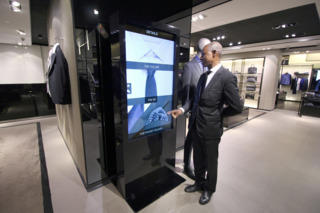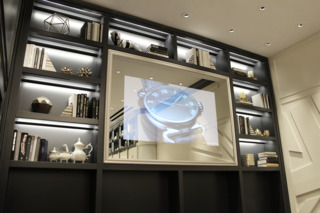Dynamic Digital Signage Lights Up the Sign Landscape
Dynamic digital signage is the future of signage for businesses.

With real time updates, businesses are always connected to their customers and can engage through personalized and innovative digital displays, said Jim Tatem, president, Signarama, United Franchise Group.
“A working network connection or internet is the only thing needed to engage and inform customers through various dynamic displays,” he added. “As the demand for digital signage increases, sign shops have a new noteworthy opportunity to serve their customers.”
Digital signage is an incredibly powerful tool when it comes to recall, influencing purchases, and reach. A recent Arbitron study showed that digital media in public venues reaches more customers than videos on Facebook.
Other studies have showed that 80% of shoppers say they’ve entered a store because a digital sign caught their interest. And once in the store, 40% of shoppers say they have changed what they purchased because of relevant information on a digital display.
It is not just retail that is benefiting. Digital signs today are used in a variety of applications. Hotels are finding that digital signage at check in can set the right impression. Communities see the benefit, too, in wayfinding and public information.
“As brands are looking to engage more with their customers, the right mix of digital and print can cause customers to pay attention,” said Michael Noerr, Coloredge VP of marketing.
International Sign Association’s (ISA) Quarterly Economic Report for the 2nd quarter of 2017 showed strong growth was anticipated in all segments of this market, confirmed Lori Anderson, CEO of ISA. “In large public display monitors, growth was particularly strong for suppliers. For screen sizes 60-69 inches, those increases were almost 17. Even larger screens—70-79 inches—were anticipated to grow year-over-year at 41%.”
Also boding well for the market is the affordability factor, as the price of screens continues to shrink, and, because of user-friendly content management systems, a relatively small team can manage a network of screens quite easily.
Coloredge brings innovation to the market
Digital signage is a key component of Coloredge’s overall strategy. The leading provider of visual marketing solutions for upscale brands and retailers, Coloredge offers its innovative solutions to its retail, QSR, entertainment venue, stadium, and arenas clients. Just one example: At the 2016 National Retail Federation BIG show, it teamed up with Samsung to showcase its digital mirror merchandising solution, which featured two displays—one using RFID-triggered content to create an interactive shopping experience, while the other was a digital mirror with suggestive selling to drive in-store sales.
“We are helping to create new store environments, as retailers try to appeal to a younger demographic, who want more of an experience when they go shopping,” said Noerr. To create unique in-store brand experiences, retailers today are blending graphical, dimensional, and digital signage.
Dynamic digital signage requires a screen, an internet connection, and software (in the form of a digital sign content management system) to manage the content and get the right content in front of the right eyeballs at the right time, explained Jeff Porter, who brings 20 years of experience in the digital signage area, presently as digital signage consultant for Coloredge and founder of Porter Digital Signage.
Every project begins with a conversation about content. “You have to feed the monster, you need a content strategy, so that’s where we like to start,” Porter explained. “Tell me about what needles you want to move, what you want to do, is it a new product introduction, an upsell? Understanding what content you need to display at what time, to move that needle, is paramount.
“You only have a few seconds or a few paces, and viewing is not necessarily taking place close to screen,” he added. “You have to have a call to action, to get people to pause for a couple of seconds—that’s all you’ve got. It’s quite critical for content to be correct, or you are wasting a lot of money. What message do we want to say very concisely to get people to "stop, drop, and roll" so to speak.”
At Coloredge’s NYC headquarters, the digital display in the lobby is changed to show new content depending on the events of the day. “Whether I am in Philly or in NY, I can manage the content from wherever I am,” said Porter. “If we want to include a welcome message, or show new content as part of a proposal for a new client, or change the content that shows at 10 am from the content on display at noon, we can easily schedule those changes.”
As you move along in the journey, the discussion becomes how to implement that strategy. What is the most efficient, successful approach to get people to stop and look at your display?
Coloredge understands how to drive that end result, and how to make sure all the moving parts are where they need to be in the process—the hardware and software, the technology that gets implemented, the creative time to develop the content, and the technical team to get it to the right place at the right time.
Watchfire delivers pixel perfect LED signs
Headquartered in Danville, Illinois, Watchfire Signs designs, engineers, and manufactures digital on-premise and outdoor LED signs. In business for 85 years, the company is no Johnny-come-lately to the sign business—Watchfire has manufactured outdoor electric signs since 1932 and LED signs since 1996. The company reports it has more than 50,000 Watchfire LED signs in operation worldwide and has more digital billboard customers in the U.S. than any other manufacturer.
When LED was first used on signage, noted Ben Barr, Watchfire Signs director of sign division sales, East Coast, only text or very large images were used. But now, higher resolution LED displays are available, at 10mm or 12mm, allowing richer, more dynamic colors to be displayed. “You can display rich, dynamic images similar to what you would capture in a photo,” noted Barr.
Watchfire’s high-resolution displays are most beneficial for locations that draw a lot of pedestrian or vehicular traffic, i.e., at a busy intersection. The closer your high-resolution LED sign is to your audience, the greater the visual impact and messaging flexibility. Large billboards on highways, for example, wouldn’t need a higher resolution display.
The tight pixel pitch on these high-resolution signs allow more graphics and content to be displayed, a plus when square footage is limited. Theaters, entertainment venues, sports arenas, and shopping malls are just a few examples of businesses using this type of sign to take advantage of close viewing range.
One recent beneficiary of the higher-resolution display is Irwin Marine in Laconia, New Hampshire. For 20 years this leading boat dealer used a manual changeable letter sign, changing that message, management estimated, 1,040 times during that period, equating to changing 40,000 letters.
This year, they switched to a 10mm LED digital display, for greater flexibility than with a static display, said Barr. “When they want to change out the message, they can do it instantly,” he added.
Advertising messages can be easily rotated from a computer using Watchfire’s programming software to include vivid images of their products, as well as timely references to local community events, such as the Easter Seals Poker Run and Greater Lakes Region Children’s Auction.
Watchfire’s digital sign content management system can be run from a desktop computer, with mobile applications also available, allowing a business to change content and scheduling remotely.
“Our biggest advantage is that we allow customers to speak to their potential business,” Barr emphasized. “Digital signage is a unique way for businesses to advertise and communicate to their audience. “
Growth opportunities
“Anyone who has old fashioned signage is a good candidate for a digital signage,” affirmed Barr.
While installations for dynamic digital signage are on an uphill scale, wide-format providers looking to add this service to their offerings need to take into consideration the logistical challenges.
In particular, Barr recommended, ensure you have a proper site survey. You’ll need to invest some time in learning what type of signage the municipality allows. “Every town or township has its own ordinances or stipulations on how signs can run,” Barr explained. “For example, they may only allow content to be changed once a day, or maybe they will allow it to changed eight times a day.” You’ll also have to look into what the rules are for nighttime vs. daytime.
The growth potential is there, but there also is the question of protecting existing client relationships, Anderson stressed. “There is no doubt that customers are looking for digital signage solutions. So often, they start that search with their sign, graphics, and visual communications company. That company is wise to be able to serve and protect that existing customer relationship—or risk it going elsewhere.”
“Learn more about the business, partner with a company like Watchfire that provides digital signage and learn from them,” said Barr. “Don’t be scared about the technology; it’s an opportunity to offer another product and service. Implementing digital signage into your existing services would be an exceptional piece.”
What ISA has found is that the vernacular used—screen resolutions, HDMI cables—can be intimidating. “But beneath it all are the same questions about branding, design, and images,” said Anderson. “Sign, graphics, and visual communications companies may need to learn a few things—or find a trusted partner. But ultimately, they have the skills needed to serve their clients in this new medium.”





